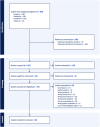The A52 Breath Method: A Narrative Review of Breathwork for Mental Health and Stress Resilience
- PMID: 40792649
- PMCID: PMC12341363
- DOI: 10.1002/smi.70098
The A52 Breath Method: A Narrative Review of Breathwork for Mental Health and Stress Resilience
Abstract
Breathwork - deliberately altering the way one breathes - has gained growing attention as an emerging non-pharmacological intervention for mental health and stress regulation. A novel yet ancient method that remains largely underexplored in the literature, breathwork requires structured, evidence-based investigation to optimize its application. This review analyses the existing literature on slow, diaphragmatic, nasal breathing and breath-holding techniques, to propose the A52 Breath Method-a theoretically grounded approach for enhancing stress resilience. A narrative review of breathwork literature was conducted that focused on the physiological and psychological mechanisms underpinning stress reduction. Medical databases were searched: 465 articles were screened and 30 studies underwent full-text review. Studies examining slow breathing (≤ 6 breaths per minute), diaphragmatic activation, nasal breathing, and breath holds were analyzed for their effects on autonomic nervous system regulation, heart rate variability (HRV), and psychological resilience. The findings indicate that slow, nasal, diaphragmatic breathing significantly improves vagal tone, HRV, parasympathetic activity, and emotional control, while reducing cortisol, anxiety, stress, and PTSD. The integration of these elements in the 5-s inhale, 5-s exhale, 2-s hold pattern (A52 Breath Method) provides a structured approach to breathwork with potential applications in high-stress professions, including emergency responders, military personnel, healthcare workers, and everyday life. The A52 Breath Method represents a novel, evidence-informed breathwork framework designed to optimize stress regulation. Future research should validate its efficacy through randomised controlled trials, particularly in populations exposed to chronic and acute stress. This conceptual model has the potential to inform clinical and occupational interventions for mental health and stress resilience.
Keywords: A52 breath method; autonomic nervous system; breath holding; breathwork; diaphragmatic breathing; heart rate variability; mental health; mental resilience; nasal breathing; stress regulation.
© 2025 The Author(s). Stress and Health published by John Wiley & Sons Ltd.
Conflict of interest statement
The author declares no conflicts of interest.
Figures




References
Publication types
MeSH terms
LinkOut - more resources
Full Text Sources
Medical

